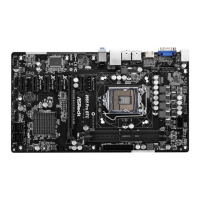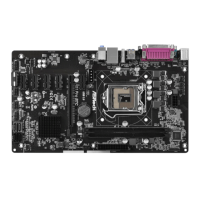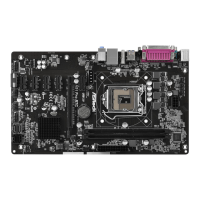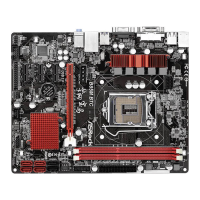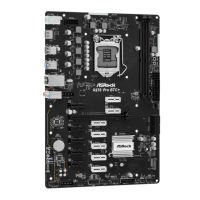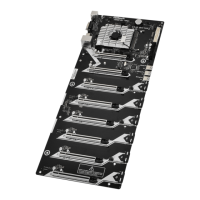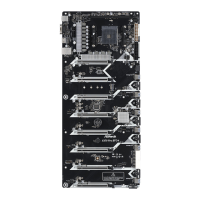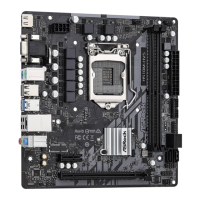Do you have a question about the ASROCK H510 Pro BTC+ and is the answer not in the manual?
Lists all items included in the motherboard package.
Details the technical specifications of the motherboard.
Provides a visual diagram of the motherboard's layout and components.
Describes the rear input/output ports of the motherboard.
Step-by-step guide for installing the Central Processing Unit (CPU).
Instructions on how to mount the CPU fan and heatsink.
Guide for installing RAM modules into the motherboard slots.
Details on using PCI Express slots and mining ports for expansion cards.
Explains how to configure jumpers for specific motherboard functions.
Identifies and explains onboard headers and connectors for system components.
Describes the function of the motherboard's smart switches.
Step-by-step instructions for installing M.2 SSD modules.
Guidance on connecting 4-pin PCIe power connectors for graphics cards.
Overview of special features of the motherboard.
Explains the feature for monitoring PCIe slot status during boot.
Details the indicator LEDs for graphics card status.
Instructions on installing necessary drivers from the support CD.
Introduction to the UEFI SETUP UTILITY and its purpose.
Describes the main menu bar options within the UEFI setup.
Explains the keyboard keys used for navigating the UEFI utility.
Overview of the system information displayed on the Main screen.
Details settings for overclocking and performance tuning.
Covers advanced system configuration options.
Configuration options related to the CPU.
Configuration options related to the motherboard chipset.
Settings for managing storage devices like SATA and M.2.
Configuration options for Super IO devices like PS/2 ports.
Settings for Advanced Configuration and Power Interface.
Configuration options for USB ports and controllers.
Settings for Trusted Computing features.
Access to various utility tools like BIOS update.
Monitors system hardware status like temperature, fan speed, and voltage.
Settings for system passwords and security features.
Configures boot settings and device priority.
Options for saving, discarding changes, and exiting the UEFI utility.
Lists all items included in the motherboard package.
Details the technical specifications of the motherboard.
Provides a visual diagram of the motherboard's layout and components.
Describes the rear input/output ports of the motherboard.
Step-by-step guide for installing the Central Processing Unit (CPU).
Instructions on how to mount the CPU fan and heatsink.
Guide for installing RAM modules into the motherboard slots.
Details on using PCI Express slots and mining ports for expansion cards.
Explains how to configure jumpers for specific motherboard functions.
Identifies and explains onboard headers and connectors for system components.
Describes the function of the motherboard's smart switches.
Step-by-step instructions for installing M.2 SSD modules.
Guidance on connecting 4-pin PCIe power connectors for graphics cards.
Overview of special features of the motherboard.
Explains the feature for monitoring PCIe slot status during boot.
Details the indicator LEDs for graphics card status.
Instructions on installing necessary drivers from the support CD.
Introduction to the UEFI SETUP UTILITY and its purpose.
Describes the main menu bar options within the UEFI setup.
Explains the keyboard keys used for navigating the UEFI utility.
Overview of the system information displayed on the Main screen.
Details settings for overclocking and performance tuning.
Covers advanced system configuration options.
Configuration options related to the CPU.
Configuration options related to the motherboard chipset.
Settings for managing storage devices like SATA and M.2.
Configuration options for Super IO devices like PS/2 ports.
Settings for Advanced Configuration and Power Interface.
Configuration options for USB ports and controllers.
Settings for Trusted Computing features.
Access to various utility tools like BIOS update.
Monitors system hardware status like temperature, fan speed, and voltage.
Settings for system passwords and security features.
Configures boot settings and device priority.
Options for saving, discarding changes, and exiting the UEFI utility.
| Processor socket | LGA 1200 (Socket H5) |
|---|---|
| Processor manufacturer | Intel |
| Compatible processor series | Intel Core i3, Intel Core i5, Intel Core i7, Intel Core i9 |
| Maximum number of SMP processors | 1 |
| Component for | PC |
| Motherboard chipset | Intel H510 |
| PC health monitoring | CPU, FAN, Voltage |
| Audio output channels | - channels |
| Motherboard form factor | - |
| Linux operating systems supported | Yes |
| Windows operating systems supported | Windows 10 x64 |
| Memory slots type | DIMM |
| Supported memory types | DDR4-SDRAM |
| Maximum internal memory | 32 GB |
| Supported memory clock speeds | 2133, 2400, 2666, 2800, 2933, 3200 MHz |
| BIOS type | UEFI AMI |
| ACPI version | 6.0 |
| BIOS memory size | 128 Mbit |
| System Management BIOS (SMBIOS) version | 2.7 |
| HDMI version | 1.4 |
| USB 2.0 ports quantity | 2 |
| USB 3.2 Gen 2 (3.1 Gen 2) Type-A ports quantity | 0 |
| Wi-Fi | No |
| LAN controller | Intel® I219-V |
| Ethernet interface type | Gigabit Ethernet |
| PCI Express x16 (Gen 3.x) slots | 6 |
| Supported storage drive types | HDD & SSD |
| Supported storage drive interfaces | M.2, SATA III |
| Cables included | SATA |
| Sustainability certificates | CE, ErP |
| Harmonized System (HS) code | 84733020 |
| Weight | 640 g |
| Depth | 224 mm |
|---|---|
| Width | 501 mm |
| Height | 70 mm |
